Strategic Analysis of Hotel Four Seasons in the Global Marketplace
VerifiedAdded on 2019/12/03
|22
|7648
|149
Report
AI Summary
This report provides a strategic analysis of Hotel Four Seasons, examining its position in the global hospitality and tourism market. It begins by identifying potential strategic trajectories, including proactive strategic orientation, adapting to changing demographics, and growth strategies through branding. The report then applies relevant models to conduct an external and competitive analysis using PESTLE analysis. It critically discusses the core capabilities and culture of Hotel Four Seasons. Furthermore, it explores the application of innovation and creativity models to improve strategy and addresses competency gaps. The report also provides a reflective learning component, demonstrating the student's understanding of the assignment's benefits.
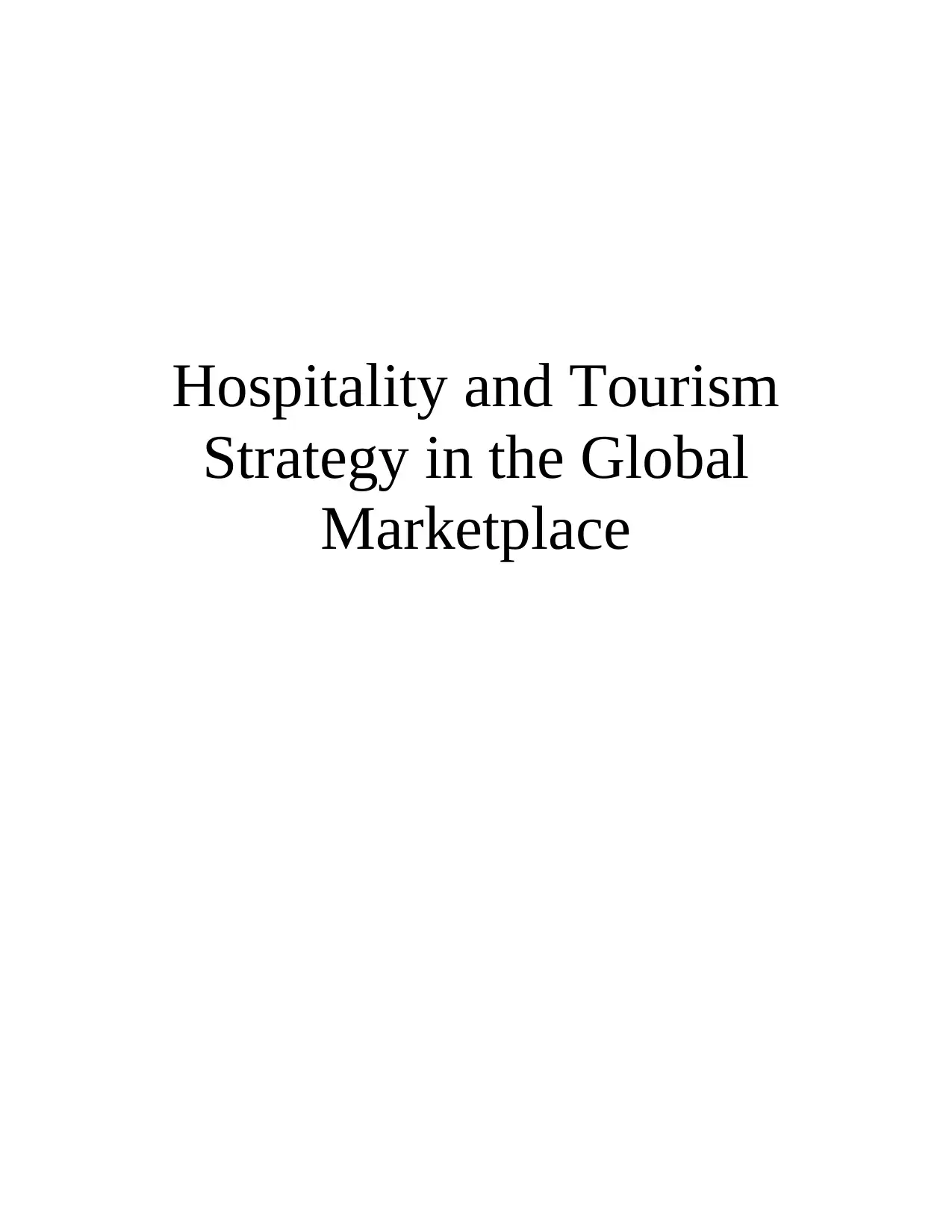
Hospitality and Tourism
Strategy in the Global
Marketplace
Strategy in the Global
Marketplace
Paraphrase This Document
Need a fresh take? Get an instant paraphrase of this document with our AI Paraphraser
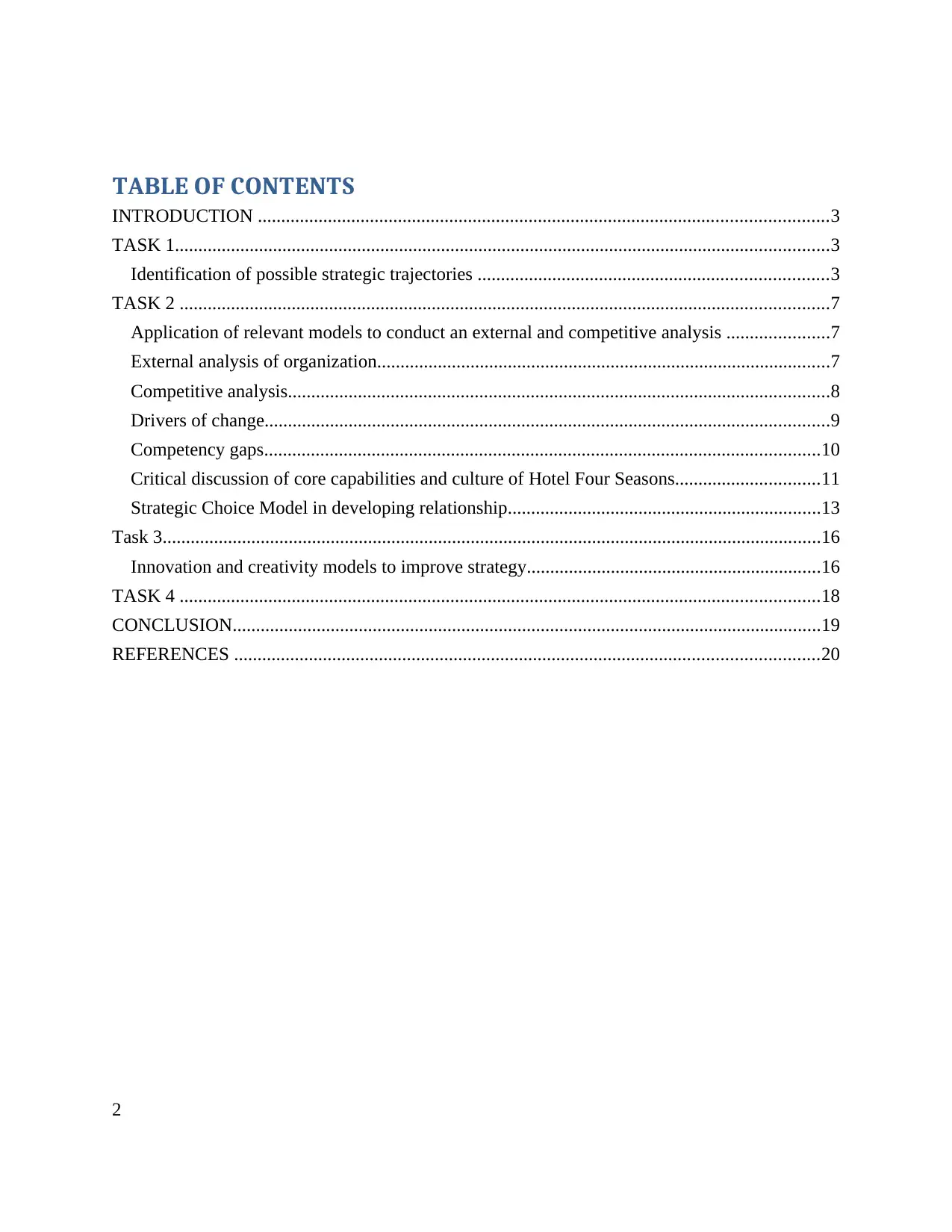
TABLE OF CONTENTS
INTRODUCTION ..........................................................................................................................3
TASK 1............................................................................................................................................3
Identification of possible strategic trajectories ...........................................................................3
TASK 2 ...........................................................................................................................................7
Application of relevant models to conduct an external and competitive analysis ......................7
External analysis of organization.................................................................................................7
Competitive analysis....................................................................................................................8
Drivers of change.........................................................................................................................9
Competency gaps.......................................................................................................................10
Critical discussion of core capabilities and culture of Hotel Four Seasons...............................11
Strategic Choice Model in developing relationship...................................................................13
Task 3.............................................................................................................................................16
Innovation and creativity models to improve strategy...............................................................16
TASK 4 .........................................................................................................................................18
CONCLUSION..............................................................................................................................19
REFERENCES .............................................................................................................................20
2
INTRODUCTION ..........................................................................................................................3
TASK 1............................................................................................................................................3
Identification of possible strategic trajectories ...........................................................................3
TASK 2 ...........................................................................................................................................7
Application of relevant models to conduct an external and competitive analysis ......................7
External analysis of organization.................................................................................................7
Competitive analysis....................................................................................................................8
Drivers of change.........................................................................................................................9
Competency gaps.......................................................................................................................10
Critical discussion of core capabilities and culture of Hotel Four Seasons...............................11
Strategic Choice Model in developing relationship...................................................................13
Task 3.............................................................................................................................................16
Innovation and creativity models to improve strategy...............................................................16
TASK 4 .........................................................................................................................................18
CONCLUSION..............................................................................................................................19
REFERENCES .............................................................................................................................20
2
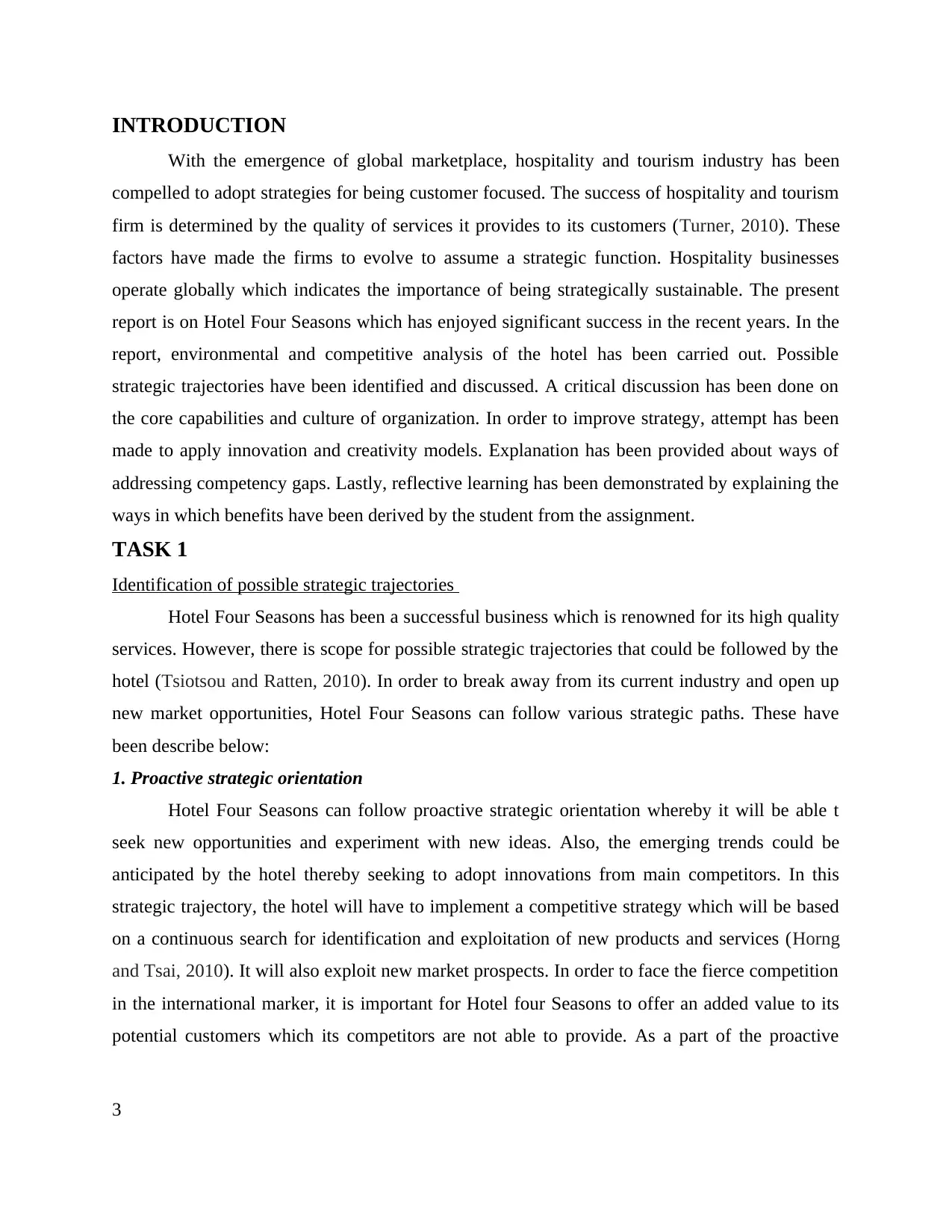
INTRODUCTION
With the emergence of global marketplace, hospitality and tourism industry has been
compelled to adopt strategies for being customer focused. The success of hospitality and tourism
firm is determined by the quality of services it provides to its customers (Turner, 2010). These
factors have made the firms to evolve to assume a strategic function. Hospitality businesses
operate globally which indicates the importance of being strategically sustainable. The present
report is on Hotel Four Seasons which has enjoyed significant success in the recent years. In the
report, environmental and competitive analysis of the hotel has been carried out. Possible
strategic trajectories have been identified and discussed. A critical discussion has been done on
the core capabilities and culture of organization. In order to improve strategy, attempt has been
made to apply innovation and creativity models. Explanation has been provided about ways of
addressing competency gaps. Lastly, reflective learning has been demonstrated by explaining the
ways in which benefits have been derived by the student from the assignment.
TASK 1
Identification of possible strategic trajectories
Hotel Four Seasons has been a successful business which is renowned for its high quality
services. However, there is scope for possible strategic trajectories that could be followed by the
hotel (Tsiotsou and Ratten, 2010). In order to break away from its current industry and open up
new market opportunities, Hotel Four Seasons can follow various strategic paths. These have
been describe below:
1. Proactive strategic orientation
Hotel Four Seasons can follow proactive strategic orientation whereby it will be able t
seek new opportunities and experiment with new ideas. Also, the emerging trends could be
anticipated by the hotel thereby seeking to adopt innovations from main competitors. In this
strategic trajectory, the hotel will have to implement a competitive strategy which will be based
on a continuous search for identification and exploitation of new products and services (Horng
and Tsai, 2010). It will also exploit new market prospects. In order to face the fierce competition
in the international marker, it is important for Hotel four Seasons to offer an added value to its
potential customers which its competitors are not able to provide. As a part of the proactive
3
With the emergence of global marketplace, hospitality and tourism industry has been
compelled to adopt strategies for being customer focused. The success of hospitality and tourism
firm is determined by the quality of services it provides to its customers (Turner, 2010). These
factors have made the firms to evolve to assume a strategic function. Hospitality businesses
operate globally which indicates the importance of being strategically sustainable. The present
report is on Hotel Four Seasons which has enjoyed significant success in the recent years. In the
report, environmental and competitive analysis of the hotel has been carried out. Possible
strategic trajectories have been identified and discussed. A critical discussion has been done on
the core capabilities and culture of organization. In order to improve strategy, attempt has been
made to apply innovation and creativity models. Explanation has been provided about ways of
addressing competency gaps. Lastly, reflective learning has been demonstrated by explaining the
ways in which benefits have been derived by the student from the assignment.
TASK 1
Identification of possible strategic trajectories
Hotel Four Seasons has been a successful business which is renowned for its high quality
services. However, there is scope for possible strategic trajectories that could be followed by the
hotel (Tsiotsou and Ratten, 2010). In order to break away from its current industry and open up
new market opportunities, Hotel Four Seasons can follow various strategic paths. These have
been describe below:
1. Proactive strategic orientation
Hotel Four Seasons can follow proactive strategic orientation whereby it will be able t
seek new opportunities and experiment with new ideas. Also, the emerging trends could be
anticipated by the hotel thereby seeking to adopt innovations from main competitors. In this
strategic trajectory, the hotel will have to implement a competitive strategy which will be based
on a continuous search for identification and exploitation of new products and services (Horng
and Tsai, 2010). It will also exploit new market prospects. In order to face the fierce competition
in the international marker, it is important for Hotel four Seasons to offer an added value to its
potential customers which its competitors are not able to provide. As a part of the proactive
3
⊘ This is a preview!⊘
Do you want full access?
Subscribe today to unlock all pages.

Trusted by 1+ million students worldwide
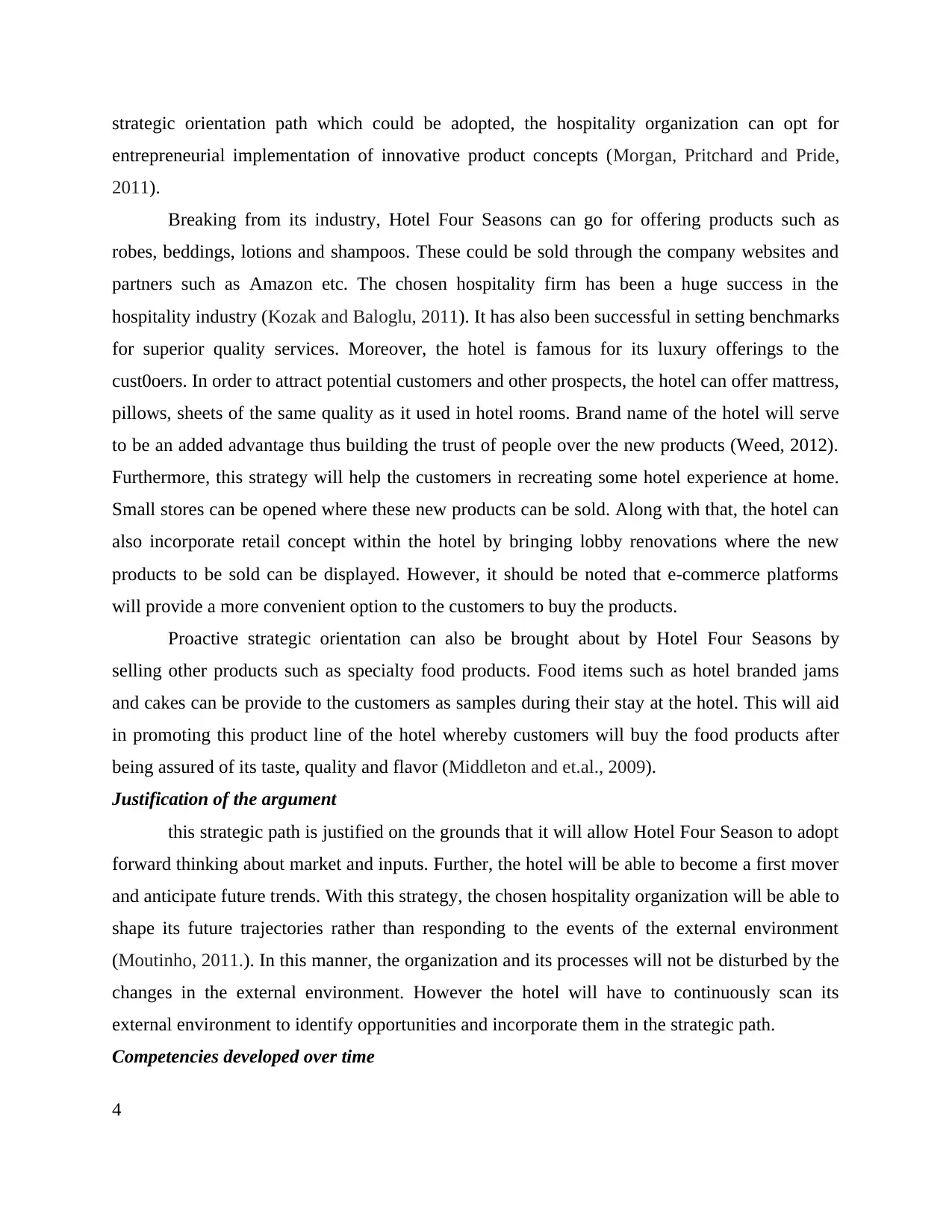
strategic orientation path which could be adopted, the hospitality organization can opt for
entrepreneurial implementation of innovative product concepts (Morgan, Pritchard and Pride,
2011).
Breaking from its industry, Hotel Four Seasons can go for offering products such as
robes, beddings, lotions and shampoos. These could be sold through the company websites and
partners such as Amazon etc. The chosen hospitality firm has been a huge success in the
hospitality industry (Kozak and Baloglu, 2011). It has also been successful in setting benchmarks
for superior quality services. Moreover, the hotel is famous for its luxury offerings to the
cust0oers. In order to attract potential customers and other prospects, the hotel can offer mattress,
pillows, sheets of the same quality as it used in hotel rooms. Brand name of the hotel will serve
to be an added advantage thus building the trust of people over the new products (Weed, 2012).
Furthermore, this strategy will help the customers in recreating some hotel experience at home.
Small stores can be opened where these new products can be sold. Along with that, the hotel can
also incorporate retail concept within the hotel by bringing lobby renovations where the new
products to be sold can be displayed. However, it should be noted that e-commerce platforms
will provide a more convenient option to the customers to buy the products.
Proactive strategic orientation can also be brought about by Hotel Four Seasons by
selling other products such as specialty food products. Food items such as hotel branded jams
and cakes can be provide to the customers as samples during their stay at the hotel. This will aid
in promoting this product line of the hotel whereby customers will buy the food products after
being assured of its taste, quality and flavor (Middleton and et.al., 2009).
Justification of the argument
this strategic path is justified on the grounds that it will allow Hotel Four Season to adopt
forward thinking about market and inputs. Further, the hotel will be able to become a first mover
and anticipate future trends. With this strategy, the chosen hospitality organization will be able to
shape its future trajectories rather than responding to the events of the external environment
(Moutinho, 2011.). In this manner, the organization and its processes will not be disturbed by the
changes in the external environment. However the hotel will have to continuously scan its
external environment to identify opportunities and incorporate them in the strategic path.
Competencies developed over time
4
entrepreneurial implementation of innovative product concepts (Morgan, Pritchard and Pride,
2011).
Breaking from its industry, Hotel Four Seasons can go for offering products such as
robes, beddings, lotions and shampoos. These could be sold through the company websites and
partners such as Amazon etc. The chosen hospitality firm has been a huge success in the
hospitality industry (Kozak and Baloglu, 2011). It has also been successful in setting benchmarks
for superior quality services. Moreover, the hotel is famous for its luxury offerings to the
cust0oers. In order to attract potential customers and other prospects, the hotel can offer mattress,
pillows, sheets of the same quality as it used in hotel rooms. Brand name of the hotel will serve
to be an added advantage thus building the trust of people over the new products (Weed, 2012).
Furthermore, this strategy will help the customers in recreating some hotel experience at home.
Small stores can be opened where these new products can be sold. Along with that, the hotel can
also incorporate retail concept within the hotel by bringing lobby renovations where the new
products to be sold can be displayed. However, it should be noted that e-commerce platforms
will provide a more convenient option to the customers to buy the products.
Proactive strategic orientation can also be brought about by Hotel Four Seasons by
selling other products such as specialty food products. Food items such as hotel branded jams
and cakes can be provide to the customers as samples during their stay at the hotel. This will aid
in promoting this product line of the hotel whereby customers will buy the food products after
being assured of its taste, quality and flavor (Middleton and et.al., 2009).
Justification of the argument
this strategic path is justified on the grounds that it will allow Hotel Four Season to adopt
forward thinking about market and inputs. Further, the hotel will be able to become a first mover
and anticipate future trends. With this strategy, the chosen hospitality organization will be able to
shape its future trajectories rather than responding to the events of the external environment
(Moutinho, 2011.). In this manner, the organization and its processes will not be disturbed by the
changes in the external environment. However the hotel will have to continuously scan its
external environment to identify opportunities and incorporate them in the strategic path.
Competencies developed over time
4
Paraphrase This Document
Need a fresh take? Get an instant paraphrase of this document with our AI Paraphraser
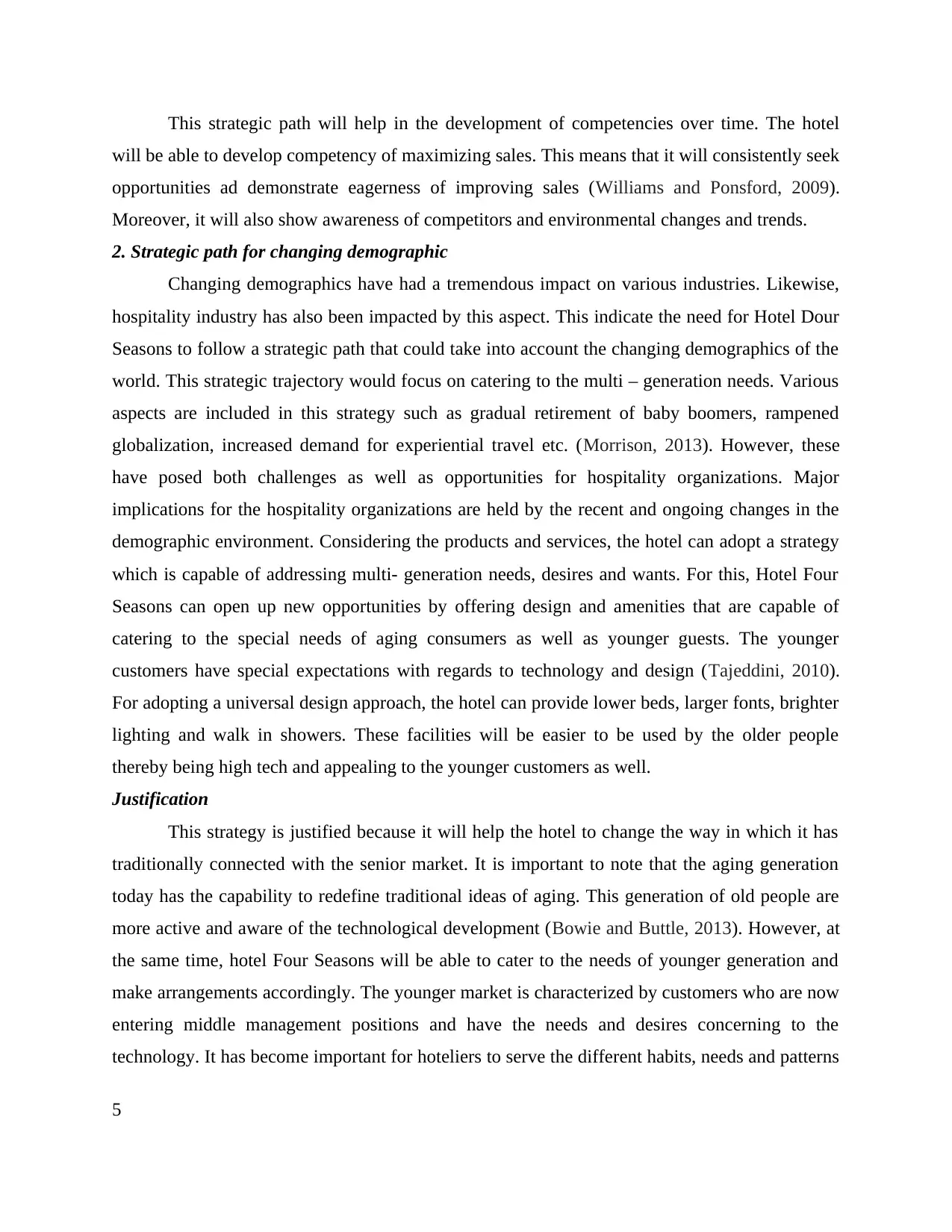
This strategic path will help in the development of competencies over time. The hotel
will be able to develop competency of maximizing sales. This means that it will consistently seek
opportunities ad demonstrate eagerness of improving sales (Williams and Ponsford, 2009).
Moreover, it will also show awareness of competitors and environmental changes and trends.
2. Strategic path for changing demographic
Changing demographics have had a tremendous impact on various industries. Likewise,
hospitality industry has also been impacted by this aspect. This indicate the need for Hotel Dour
Seasons to follow a strategic path that could take into account the changing demographics of the
world. This strategic trajectory would focus on catering to the multi – generation needs. Various
aspects are included in this strategy such as gradual retirement of baby boomers, rampened
globalization, increased demand for experiential travel etc. (Morrison, 2013). However, these
have posed both challenges as well as opportunities for hospitality organizations. Major
implications for the hospitality organizations are held by the recent and ongoing changes in the
demographic environment. Considering the products and services, the hotel can adopt a strategy
which is capable of addressing multi- generation needs, desires and wants. For this, Hotel Four
Seasons can open up new opportunities by offering design and amenities that are capable of
catering to the special needs of aging consumers as well as younger guests. The younger
customers have special expectations with regards to technology and design (Tajeddini, 2010).
For adopting a universal design approach, the hotel can provide lower beds, larger fonts, brighter
lighting and walk in showers. These facilities will be easier to be used by the older people
thereby being high tech and appealing to the younger customers as well.
Justification
This strategy is justified because it will help the hotel to change the way in which it has
traditionally connected with the senior market. It is important to note that the aging generation
today has the capability to redefine traditional ideas of aging. This generation of old people are
more active and aware of the technological development (Bowie and Buttle, 2013). However, at
the same time, hotel Four Seasons will be able to cater to the needs of younger generation and
make arrangements accordingly. The younger market is characterized by customers who are now
entering middle management positions and have the needs and desires concerning to the
technology. It has become important for hoteliers to serve the different habits, needs and patterns
5
will be able to develop competency of maximizing sales. This means that it will consistently seek
opportunities ad demonstrate eagerness of improving sales (Williams and Ponsford, 2009).
Moreover, it will also show awareness of competitors and environmental changes and trends.
2. Strategic path for changing demographic
Changing demographics have had a tremendous impact on various industries. Likewise,
hospitality industry has also been impacted by this aspect. This indicate the need for Hotel Dour
Seasons to follow a strategic path that could take into account the changing demographics of the
world. This strategic trajectory would focus on catering to the multi – generation needs. Various
aspects are included in this strategy such as gradual retirement of baby boomers, rampened
globalization, increased demand for experiential travel etc. (Morrison, 2013). However, these
have posed both challenges as well as opportunities for hospitality organizations. Major
implications for the hospitality organizations are held by the recent and ongoing changes in the
demographic environment. Considering the products and services, the hotel can adopt a strategy
which is capable of addressing multi- generation needs, desires and wants. For this, Hotel Four
Seasons can open up new opportunities by offering design and amenities that are capable of
catering to the special needs of aging consumers as well as younger guests. The younger
customers have special expectations with regards to technology and design (Tajeddini, 2010).
For adopting a universal design approach, the hotel can provide lower beds, larger fonts, brighter
lighting and walk in showers. These facilities will be easier to be used by the older people
thereby being high tech and appealing to the younger customers as well.
Justification
This strategy is justified because it will help the hotel to change the way in which it has
traditionally connected with the senior market. It is important to note that the aging generation
today has the capability to redefine traditional ideas of aging. This generation of old people are
more active and aware of the technological development (Bowie and Buttle, 2013). However, at
the same time, hotel Four Seasons will be able to cater to the needs of younger generation and
make arrangements accordingly. The younger market is characterized by customers who are now
entering middle management positions and have the needs and desires concerning to the
technology. It has become important for hoteliers to serve the different habits, needs and patterns
5
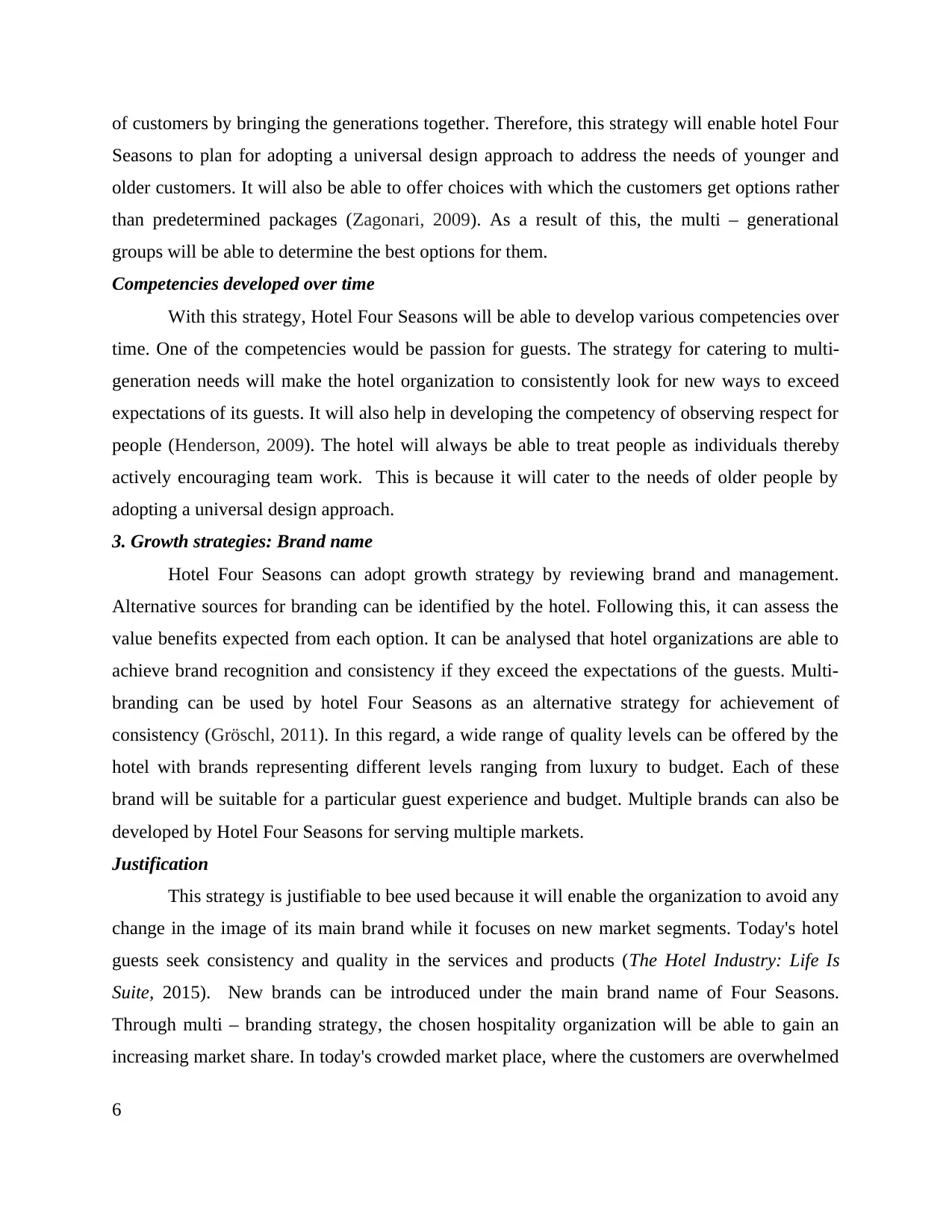
of customers by bringing the generations together. Therefore, this strategy will enable hotel Four
Seasons to plan for adopting a universal design approach to address the needs of younger and
older customers. It will also be able to offer choices with which the customers get options rather
than predetermined packages (Zagonari, 2009). As a result of this, the multi – generational
groups will be able to determine the best options for them.
Competencies developed over time
With this strategy, Hotel Four Seasons will be able to develop various competencies over
time. One of the competencies would be passion for guests. The strategy for catering to multi-
generation needs will make the hotel organization to consistently look for new ways to exceed
expectations of its guests. It will also help in developing the competency of observing respect for
people (Henderson, 2009). The hotel will always be able to treat people as individuals thereby
actively encouraging team work. This is because it will cater to the needs of older people by
adopting a universal design approach.
3. Growth strategies: Brand name
Hotel Four Seasons can adopt growth strategy by reviewing brand and management.
Alternative sources for branding can be identified by the hotel. Following this, it can assess the
value benefits expected from each option. It can be analysed that hotel organizations are able to
achieve brand recognition and consistency if they exceed the expectations of the guests. Multi-
branding can be used by hotel Four Seasons as an alternative strategy for achievement of
consistency (Gröschl, 2011). In this regard, a wide range of quality levels can be offered by the
hotel with brands representing different levels ranging from luxury to budget. Each of these
brand will be suitable for a particular guest experience and budget. Multiple brands can also be
developed by Hotel Four Seasons for serving multiple markets.
Justification
This strategy is justifiable to bee used because it will enable the organization to avoid any
change in the image of its main brand while it focuses on new market segments. Today's hotel
guests seek consistency and quality in the services and products (The Hotel Industry: Life Is
Suite, 2015). New brands can be introduced under the main brand name of Four Seasons.
Through multi – branding strategy, the chosen hospitality organization will be able to gain an
increasing market share. In today's crowded market place, where the customers are overwhelmed
6
Seasons to plan for adopting a universal design approach to address the needs of younger and
older customers. It will also be able to offer choices with which the customers get options rather
than predetermined packages (Zagonari, 2009). As a result of this, the multi – generational
groups will be able to determine the best options for them.
Competencies developed over time
With this strategy, Hotel Four Seasons will be able to develop various competencies over
time. One of the competencies would be passion for guests. The strategy for catering to multi-
generation needs will make the hotel organization to consistently look for new ways to exceed
expectations of its guests. It will also help in developing the competency of observing respect for
people (Henderson, 2009). The hotel will always be able to treat people as individuals thereby
actively encouraging team work. This is because it will cater to the needs of older people by
adopting a universal design approach.
3. Growth strategies: Brand name
Hotel Four Seasons can adopt growth strategy by reviewing brand and management.
Alternative sources for branding can be identified by the hotel. Following this, it can assess the
value benefits expected from each option. It can be analysed that hotel organizations are able to
achieve brand recognition and consistency if they exceed the expectations of the guests. Multi-
branding can be used by hotel Four Seasons as an alternative strategy for achievement of
consistency (Gröschl, 2011). In this regard, a wide range of quality levels can be offered by the
hotel with brands representing different levels ranging from luxury to budget. Each of these
brand will be suitable for a particular guest experience and budget. Multiple brands can also be
developed by Hotel Four Seasons for serving multiple markets.
Justification
This strategy is justifiable to bee used because it will enable the organization to avoid any
change in the image of its main brand while it focuses on new market segments. Today's hotel
guests seek consistency and quality in the services and products (The Hotel Industry: Life Is
Suite, 2015). New brands can be introduced under the main brand name of Four Seasons.
Through multi – branding strategy, the chosen hospitality organization will be able to gain an
increasing market share. In today's crowded market place, where the customers are overwhelmed
6
⊘ This is a preview!⊘
Do you want full access?
Subscribe today to unlock all pages.

Trusted by 1+ million students worldwide
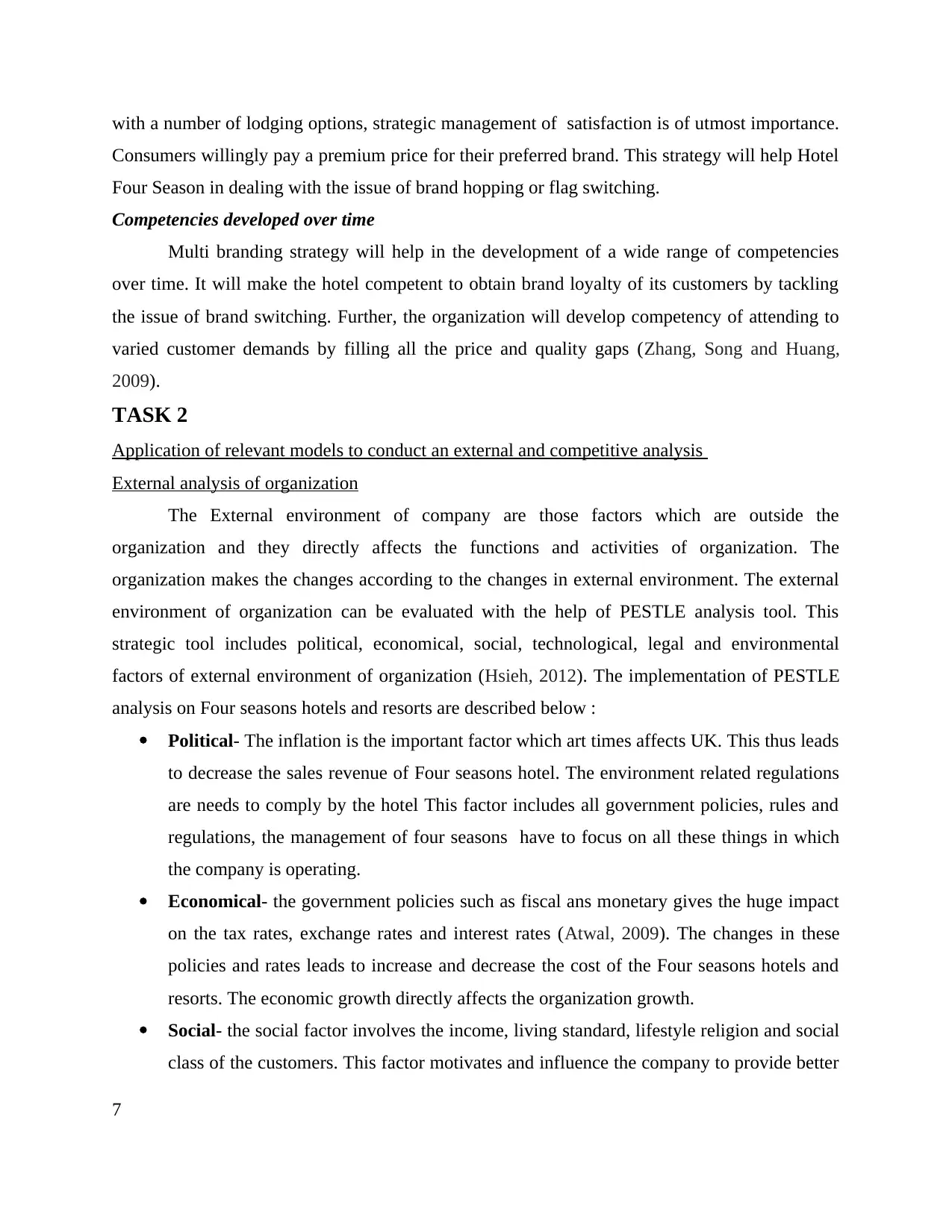
with a number of lodging options, strategic management of satisfaction is of utmost importance.
Consumers willingly pay a premium price for their preferred brand. This strategy will help Hotel
Four Season in dealing with the issue of brand hopping or flag switching.
Competencies developed over time
Multi branding strategy will help in the development of a wide range of competencies
over time. It will make the hotel competent to obtain brand loyalty of its customers by tackling
the issue of brand switching. Further, the organization will develop competency of attending to
varied customer demands by filling all the price and quality gaps (Zhang, Song and Huang,
2009).
TASK 2
Application of relevant models to conduct an external and competitive analysis
External analysis of organization
The External environment of company are those factors which are outside the
organization and they directly affects the functions and activities of organization. The
organization makes the changes according to the changes in external environment. The external
environment of organization can be evaluated with the help of PESTLE analysis tool. This
strategic tool includes political, economical, social, technological, legal and environmental
factors of external environment of organization (Hsieh, 2012). The implementation of PESTLE
analysis on Four seasons hotels and resorts are described below :
Political- The inflation is the important factor which art times affects UK. This thus leads
to decrease the sales revenue of Four seasons hotel. The environment related regulations
are needs to comply by the hotel This factor includes all government policies, rules and
regulations, the management of four seasons have to focus on all these things in which
the company is operating.
Economical- the government policies such as fiscal ans monetary gives the huge impact
on the tax rates, exchange rates and interest rates (Atwal, 2009). The changes in these
policies and rates leads to increase and decrease the cost of the Four seasons hotels and
resorts. The economic growth directly affects the organization growth.
Social- the social factor involves the income, living standard, lifestyle religion and social
class of the customers. This factor motivates and influence the company to provide better
7
Consumers willingly pay a premium price for their preferred brand. This strategy will help Hotel
Four Season in dealing with the issue of brand hopping or flag switching.
Competencies developed over time
Multi branding strategy will help in the development of a wide range of competencies
over time. It will make the hotel competent to obtain brand loyalty of its customers by tackling
the issue of brand switching. Further, the organization will develop competency of attending to
varied customer demands by filling all the price and quality gaps (Zhang, Song and Huang,
2009).
TASK 2
Application of relevant models to conduct an external and competitive analysis
External analysis of organization
The External environment of company are those factors which are outside the
organization and they directly affects the functions and activities of organization. The
organization makes the changes according to the changes in external environment. The external
environment of organization can be evaluated with the help of PESTLE analysis tool. This
strategic tool includes political, economical, social, technological, legal and environmental
factors of external environment of organization (Hsieh, 2012). The implementation of PESTLE
analysis on Four seasons hotels and resorts are described below :
Political- The inflation is the important factor which art times affects UK. This thus leads
to decrease the sales revenue of Four seasons hotel. The environment related regulations
are needs to comply by the hotel This factor includes all government policies, rules and
regulations, the management of four seasons have to focus on all these things in which
the company is operating.
Economical- the government policies such as fiscal ans monetary gives the huge impact
on the tax rates, exchange rates and interest rates (Atwal, 2009). The changes in these
policies and rates leads to increase and decrease the cost of the Four seasons hotels and
resorts. The economic growth directly affects the organization growth.
Social- the social factor involves the income, living standard, lifestyle religion and social
class of the customers. This factor motivates and influence the company to provide better
7
Paraphrase This Document
Need a fresh take? Get an instant paraphrase of this document with our AI Paraphraser
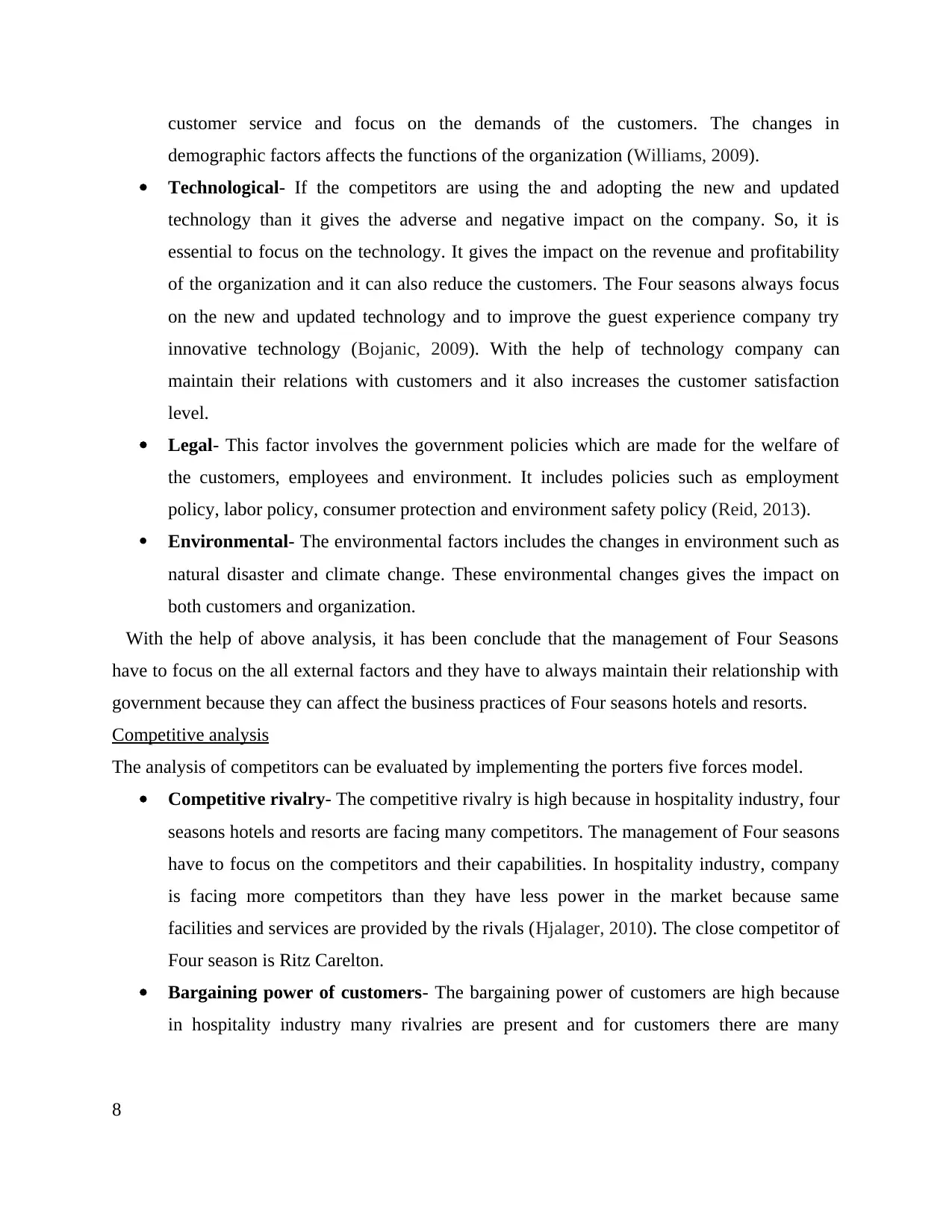
customer service and focus on the demands of the customers. The changes in
demographic factors affects the functions of the organization (Williams, 2009).
Technological- If the competitors are using the and adopting the new and updated
technology than it gives the adverse and negative impact on the company. So, it is
essential to focus on the technology. It gives the impact on the revenue and profitability
of the organization and it can also reduce the customers. The Four seasons always focus
on the new and updated technology and to improve the guest experience company try
innovative technology (Bojanic, 2009). With the help of technology company can
maintain their relations with customers and it also increases the customer satisfaction
level.
Legal- This factor involves the government policies which are made for the welfare of
the customers, employees and environment. It includes policies such as employment
policy, labor policy, consumer protection and environment safety policy (Reid, 2013).
Environmental- The environmental factors includes the changes in environment such as
natural disaster and climate change. These environmental changes gives the impact on
both customers and organization.
With the help of above analysis, it has been conclude that the management of Four Seasons
have to focus on the all external factors and they have to always maintain their relationship with
government because they can affect the business practices of Four seasons hotels and resorts.
Competitive analysis
The analysis of competitors can be evaluated by implementing the porters five forces model.
Competitive rivalry- The competitive rivalry is high because in hospitality industry, four
seasons hotels and resorts are facing many competitors. The management of Four seasons
have to focus on the competitors and their capabilities. In hospitality industry, company
is facing more competitors than they have less power in the market because same
facilities and services are provided by the rivals (Hjalager, 2010). The close competitor of
Four season is Ritz Carelton.
Bargaining power of customers- The bargaining power of customers are high because
in hospitality industry many rivalries are present and for customers there are many
8
demographic factors affects the functions of the organization (Williams, 2009).
Technological- If the competitors are using the and adopting the new and updated
technology than it gives the adverse and negative impact on the company. So, it is
essential to focus on the technology. It gives the impact on the revenue and profitability
of the organization and it can also reduce the customers. The Four seasons always focus
on the new and updated technology and to improve the guest experience company try
innovative technology (Bojanic, 2009). With the help of technology company can
maintain their relations with customers and it also increases the customer satisfaction
level.
Legal- This factor involves the government policies which are made for the welfare of
the customers, employees and environment. It includes policies such as employment
policy, labor policy, consumer protection and environment safety policy (Reid, 2013).
Environmental- The environmental factors includes the changes in environment such as
natural disaster and climate change. These environmental changes gives the impact on
both customers and organization.
With the help of above analysis, it has been conclude that the management of Four Seasons
have to focus on the all external factors and they have to always maintain their relationship with
government because they can affect the business practices of Four seasons hotels and resorts.
Competitive analysis
The analysis of competitors can be evaluated by implementing the porters five forces model.
Competitive rivalry- The competitive rivalry is high because in hospitality industry, four
seasons hotels and resorts are facing many competitors. The management of Four seasons
have to focus on the competitors and their capabilities. In hospitality industry, company
is facing more competitors than they have less power in the market because same
facilities and services are provided by the rivals (Hjalager, 2010). The close competitor of
Four season is Ritz Carelton.
Bargaining power of customers- The bargaining power of customers are high because
in hospitality industry many rivalries are present and for customers there are many
8
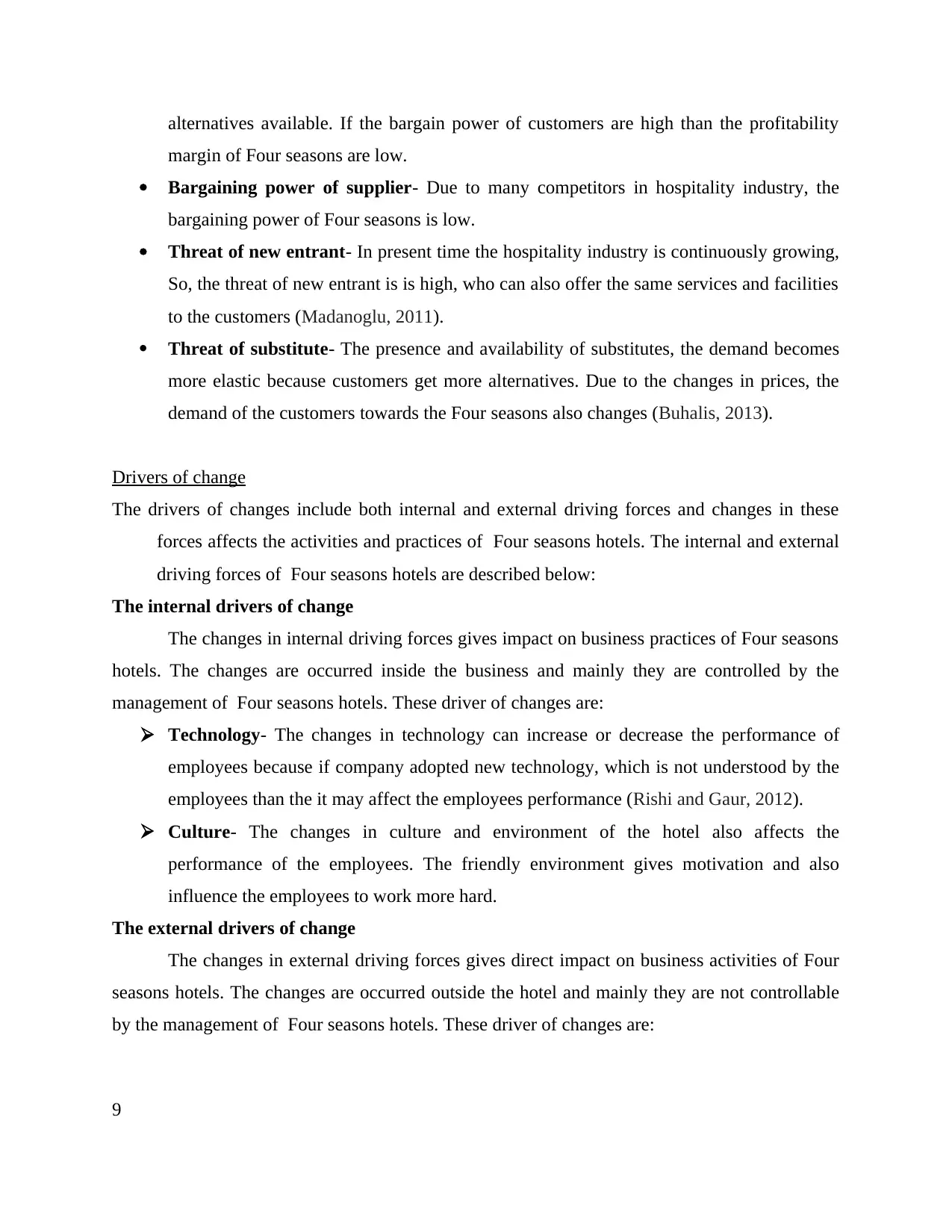
alternatives available. If the bargain power of customers are high than the profitability
margin of Four seasons are low.
Bargaining power of supplier- Due to many competitors in hospitality industry, the
bargaining power of Four seasons is low.
Threat of new entrant- In present time the hospitality industry is continuously growing,
So, the threat of new entrant is is high, who can also offer the same services and facilities
to the customers (Madanoglu, 2011).
Threat of substitute- The presence and availability of substitutes, the demand becomes
more elastic because customers get more alternatives. Due to the changes in prices, the
demand of the customers towards the Four seasons also changes (Buhalis, 2013).
Drivers of change
The drivers of changes include both internal and external driving forces and changes in these
forces affects the activities and practices of Four seasons hotels. The internal and external
driving forces of Four seasons hotels are described below:
The internal drivers of change
The changes in internal driving forces gives impact on business practices of Four seasons
hotels. The changes are occurred inside the business and mainly they are controlled by the
management of Four seasons hotels. These driver of changes are:
Technology- The changes in technology can increase or decrease the performance of
employees because if company adopted new technology, which is not understood by the
employees than the it may affect the employees performance (Rishi and Gaur, 2012).
Culture- The changes in culture and environment of the hotel also affects the
performance of the employees. The friendly environment gives motivation and also
influence the employees to work more hard.
The external drivers of change
The changes in external driving forces gives direct impact on business activities of Four
seasons hotels. The changes are occurred outside the hotel and mainly they are not controllable
by the management of Four seasons hotels. These driver of changes are:
9
margin of Four seasons are low.
Bargaining power of supplier- Due to many competitors in hospitality industry, the
bargaining power of Four seasons is low.
Threat of new entrant- In present time the hospitality industry is continuously growing,
So, the threat of new entrant is is high, who can also offer the same services and facilities
to the customers (Madanoglu, 2011).
Threat of substitute- The presence and availability of substitutes, the demand becomes
more elastic because customers get more alternatives. Due to the changes in prices, the
demand of the customers towards the Four seasons also changes (Buhalis, 2013).
Drivers of change
The drivers of changes include both internal and external driving forces and changes in these
forces affects the activities and practices of Four seasons hotels. The internal and external
driving forces of Four seasons hotels are described below:
The internal drivers of change
The changes in internal driving forces gives impact on business practices of Four seasons
hotels. The changes are occurred inside the business and mainly they are controlled by the
management of Four seasons hotels. These driver of changes are:
Technology- The changes in technology can increase or decrease the performance of
employees because if company adopted new technology, which is not understood by the
employees than the it may affect the employees performance (Rishi and Gaur, 2012).
Culture- The changes in culture and environment of the hotel also affects the
performance of the employees. The friendly environment gives motivation and also
influence the employees to work more hard.
The external drivers of change
The changes in external driving forces gives direct impact on business activities of Four
seasons hotels. The changes are occurred outside the hotel and mainly they are not controllable
by the management of Four seasons hotels. These driver of changes are:
9
⊘ This is a preview!⊘
Do you want full access?
Subscribe today to unlock all pages.

Trusted by 1+ million students worldwide
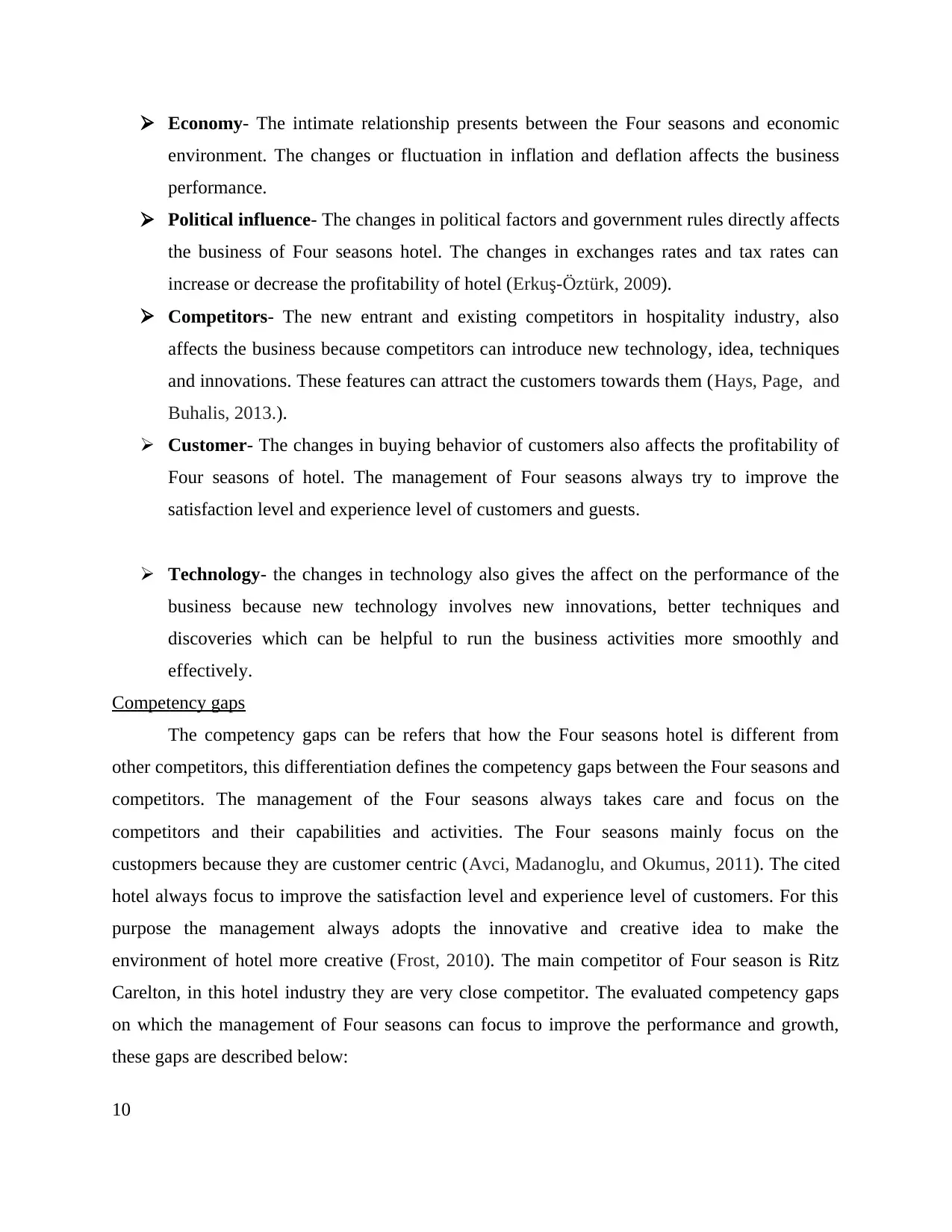
Economy- The intimate relationship presents between the Four seasons and economic
environment. The changes or fluctuation in inflation and deflation affects the business
performance.
Political influence- The changes in political factors and government rules directly affects
the business of Four seasons hotel. The changes in exchanges rates and tax rates can
increase or decrease the profitability of hotel (Erkuş-Öztürk, 2009).
Competitors- The new entrant and existing competitors in hospitality industry, also
affects the business because competitors can introduce new technology, idea, techniques
and innovations. These features can attract the customers towards them (Hays, Page, and
Buhalis, 2013.).
Customer- The changes in buying behavior of customers also affects the profitability of
Four seasons of hotel. The management of Four seasons always try to improve the
satisfaction level and experience level of customers and guests.
Technology- the changes in technology also gives the affect on the performance of the
business because new technology involves new innovations, better techniques and
discoveries which can be helpful to run the business activities more smoothly and
effectively.
Competency gaps
The competency gaps can be refers that how the Four seasons hotel is different from
other competitors, this differentiation defines the competency gaps between the Four seasons and
competitors. The management of the Four seasons always takes care and focus on the
competitors and their capabilities and activities. The Four seasons mainly focus on the
custopmers because they are customer centric (Avci, Madanoglu, and Okumus, 2011). The cited
hotel always focus to improve the satisfaction level and experience level of customers. For this
purpose the management always adopts the innovative and creative idea to make the
environment of hotel more creative (Frost, 2010). The main competitor of Four season is Ritz
Carelton, in this hotel industry they are very close competitor. The evaluated competency gaps
on which the management of Four seasons can focus to improve the performance and growth,
these gaps are described below:
10
environment. The changes or fluctuation in inflation and deflation affects the business
performance.
Political influence- The changes in political factors and government rules directly affects
the business of Four seasons hotel. The changes in exchanges rates and tax rates can
increase or decrease the profitability of hotel (Erkuş-Öztürk, 2009).
Competitors- The new entrant and existing competitors in hospitality industry, also
affects the business because competitors can introduce new technology, idea, techniques
and innovations. These features can attract the customers towards them (Hays, Page, and
Buhalis, 2013.).
Customer- The changes in buying behavior of customers also affects the profitability of
Four seasons of hotel. The management of Four seasons always try to improve the
satisfaction level and experience level of customers and guests.
Technology- the changes in technology also gives the affect on the performance of the
business because new technology involves new innovations, better techniques and
discoveries which can be helpful to run the business activities more smoothly and
effectively.
Competency gaps
The competency gaps can be refers that how the Four seasons hotel is different from
other competitors, this differentiation defines the competency gaps between the Four seasons and
competitors. The management of the Four seasons always takes care and focus on the
competitors and their capabilities and activities. The Four seasons mainly focus on the
custopmers because they are customer centric (Avci, Madanoglu, and Okumus, 2011). The cited
hotel always focus to improve the satisfaction level and experience level of customers. For this
purpose the management always adopts the innovative and creative idea to make the
environment of hotel more creative (Frost, 2010). The main competitor of Four season is Ritz
Carelton, in this hotel industry they are very close competitor. The evaluated competency gaps
on which the management of Four seasons can focus to improve the performance and growth,
these gaps are described below:
10
Paraphrase This Document
Need a fresh take? Get an instant paraphrase of this document with our AI Paraphraser
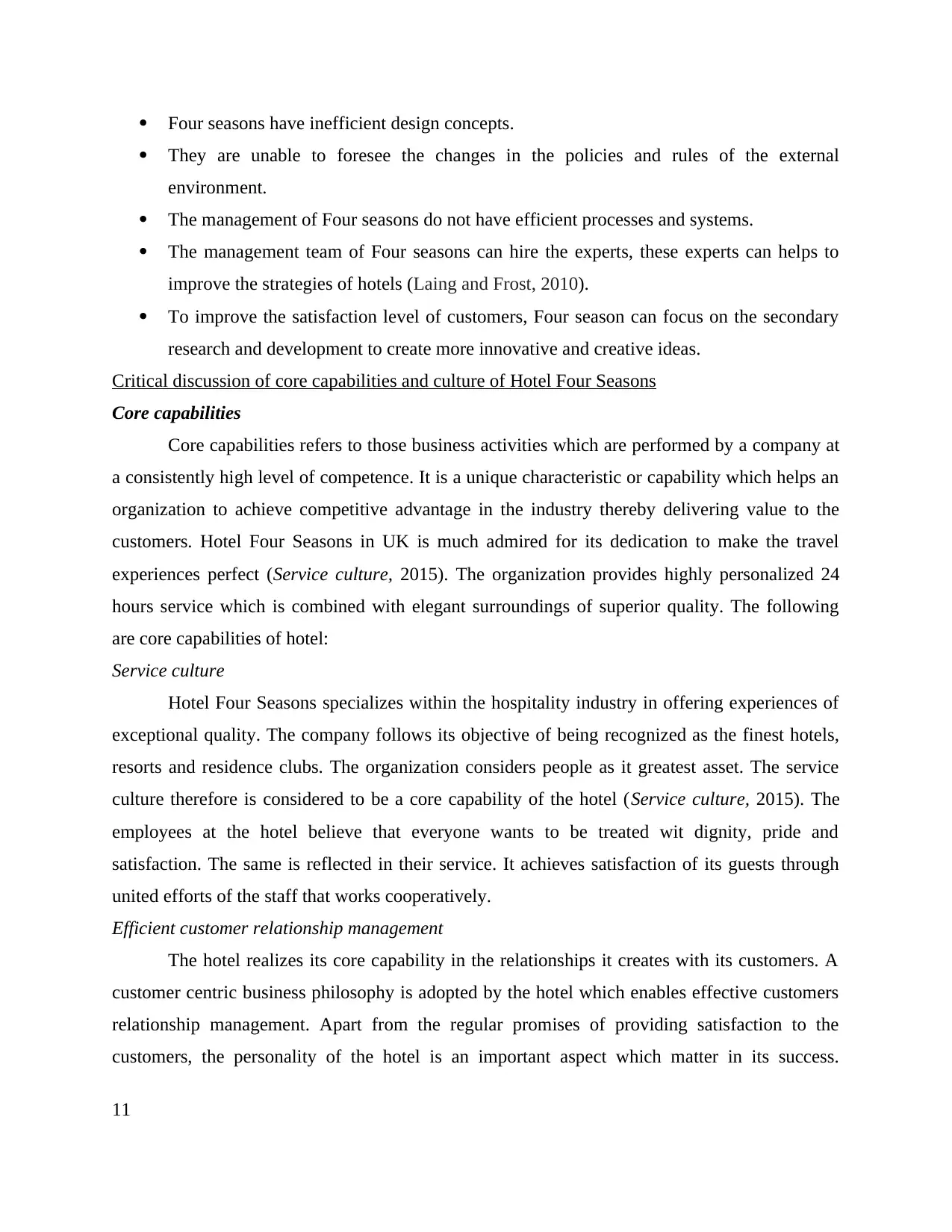
Four seasons have inefficient design concepts.
They are unable to foresee the changes in the policies and rules of the external
environment.
The management of Four seasons do not have efficient processes and systems.
The management team of Four seasons can hire the experts, these experts can helps to
improve the strategies of hotels (Laing and Frost, 2010).
To improve the satisfaction level of customers, Four season can focus on the secondary
research and development to create more innovative and creative ideas.
Critical discussion of core capabilities and culture of Hotel Four Seasons
Core capabilities
Core capabilities refers to those business activities which are performed by a company at
a consistently high level of competence. It is a unique characteristic or capability which helps an
organization to achieve competitive advantage in the industry thereby delivering value to the
customers. Hotel Four Seasons in UK is much admired for its dedication to make the travel
experiences perfect (Service culture, 2015). The organization provides highly personalized 24
hours service which is combined with elegant surroundings of superior quality. The following
are core capabilities of hotel:
Service culture
Hotel Four Seasons specializes within the hospitality industry in offering experiences of
exceptional quality. The company follows its objective of being recognized as the finest hotels,
resorts and residence clubs. The organization considers people as it greatest asset. The service
culture therefore is considered to be a core capability of the hotel (Service culture, 2015). The
employees at the hotel believe that everyone wants to be treated wit dignity, pride and
satisfaction. The same is reflected in their service. It achieves satisfaction of its guests through
united efforts of the staff that works cooperatively.
Efficient customer relationship management
The hotel realizes its core capability in the relationships it creates with its customers. A
customer centric business philosophy is adopted by the hotel which enables effective customers
relationship management. Apart from the regular promises of providing satisfaction to the
customers, the personality of the hotel is an important aspect which matter in its success.
11
They are unable to foresee the changes in the policies and rules of the external
environment.
The management of Four seasons do not have efficient processes and systems.
The management team of Four seasons can hire the experts, these experts can helps to
improve the strategies of hotels (Laing and Frost, 2010).
To improve the satisfaction level of customers, Four season can focus on the secondary
research and development to create more innovative and creative ideas.
Critical discussion of core capabilities and culture of Hotel Four Seasons
Core capabilities
Core capabilities refers to those business activities which are performed by a company at
a consistently high level of competence. It is a unique characteristic or capability which helps an
organization to achieve competitive advantage in the industry thereby delivering value to the
customers. Hotel Four Seasons in UK is much admired for its dedication to make the travel
experiences perfect (Service culture, 2015). The organization provides highly personalized 24
hours service which is combined with elegant surroundings of superior quality. The following
are core capabilities of hotel:
Service culture
Hotel Four Seasons specializes within the hospitality industry in offering experiences of
exceptional quality. The company follows its objective of being recognized as the finest hotels,
resorts and residence clubs. The organization considers people as it greatest asset. The service
culture therefore is considered to be a core capability of the hotel (Service culture, 2015). The
employees at the hotel believe that everyone wants to be treated wit dignity, pride and
satisfaction. The same is reflected in their service. It achieves satisfaction of its guests through
united efforts of the staff that works cooperatively.
Efficient customer relationship management
The hotel realizes its core capability in the relationships it creates with its customers. A
customer centric business philosophy is adopted by the hotel which enables effective customers
relationship management. Apart from the regular promises of providing satisfaction to the
customers, the personality of the hotel is an important aspect which matter in its success.
11
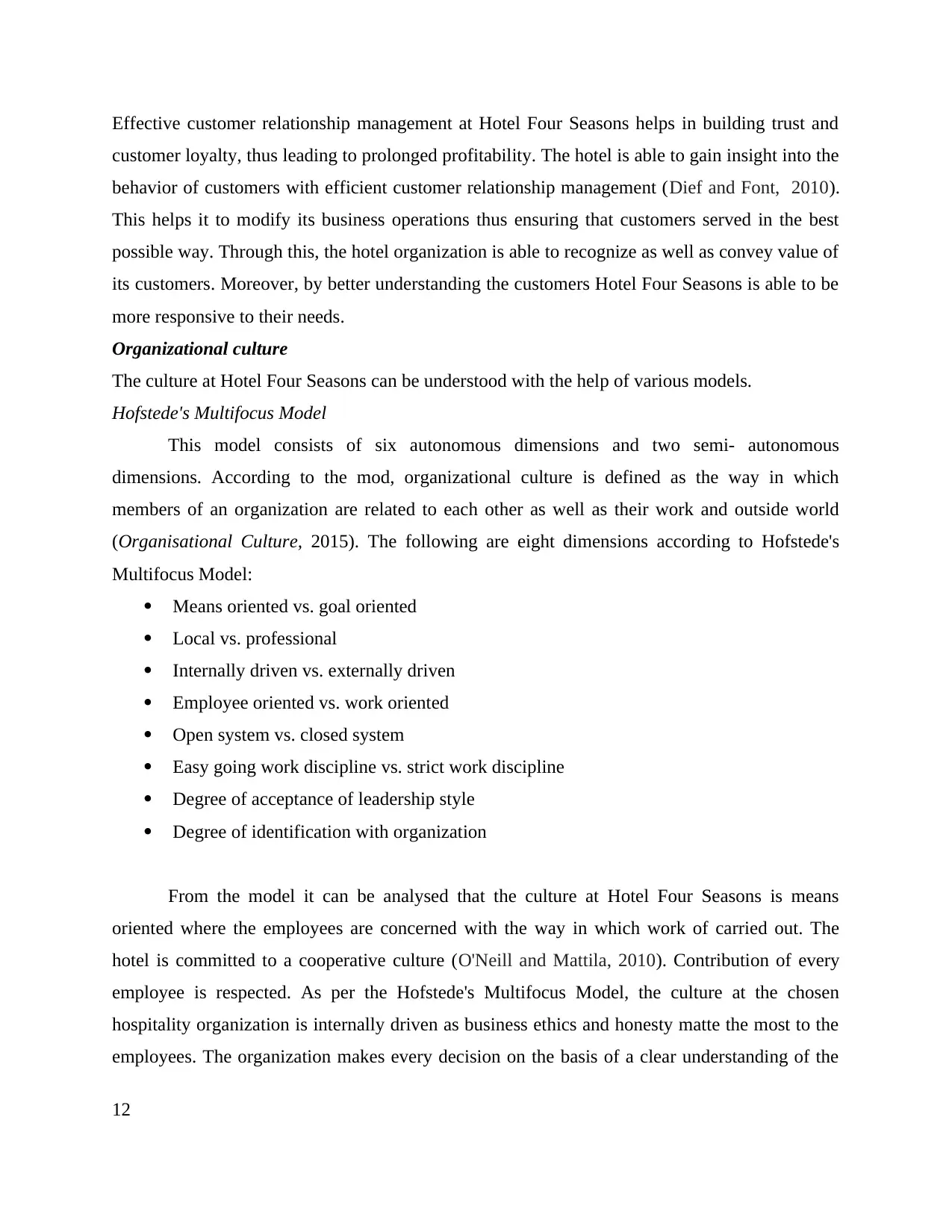
Effective customer relationship management at Hotel Four Seasons helps in building trust and
customer loyalty, thus leading to prolonged profitability. The hotel is able to gain insight into the
behavior of customers with efficient customer relationship management (Dief and Font, 2010).
This helps it to modify its business operations thus ensuring that customers served in the best
possible way. Through this, the hotel organization is able to recognize as well as convey value of
its customers. Moreover, by better understanding the customers Hotel Four Seasons is able to be
more responsive to their needs.
Organizational culture
The culture at Hotel Four Seasons can be understood with the help of various models.
Hofstede's Multifocus Model
This model consists of six autonomous dimensions and two semi- autonomous
dimensions. According to the mod, organizational culture is defined as the way in which
members of an organization are related to each other as well as their work and outside world
(Organisational Culture, 2015). The following are eight dimensions according to Hofstede's
Multifocus Model:
Means oriented vs. goal oriented
Local vs. professional
Internally driven vs. externally driven
Employee oriented vs. work oriented
Open system vs. closed system
Easy going work discipline vs. strict work discipline
Degree of acceptance of leadership style
Degree of identification with organization
From the model it can be analysed that the culture at Hotel Four Seasons is means
oriented where the employees are concerned with the way in which work of carried out. The
hotel is committed to a cooperative culture (O'Neill and Mattila, 2010). Contribution of every
employee is respected. As per the Hofstede's Multifocus Model, the culture at the chosen
hospitality organization is internally driven as business ethics and honesty matte the most to the
employees. The organization makes every decision on the basis of a clear understanding of the
12
customer loyalty, thus leading to prolonged profitability. The hotel is able to gain insight into the
behavior of customers with efficient customer relationship management (Dief and Font, 2010).
This helps it to modify its business operations thus ensuring that customers served in the best
possible way. Through this, the hotel organization is able to recognize as well as convey value of
its customers. Moreover, by better understanding the customers Hotel Four Seasons is able to be
more responsive to their needs.
Organizational culture
The culture at Hotel Four Seasons can be understood with the help of various models.
Hofstede's Multifocus Model
This model consists of six autonomous dimensions and two semi- autonomous
dimensions. According to the mod, organizational culture is defined as the way in which
members of an organization are related to each other as well as their work and outside world
(Organisational Culture, 2015). The following are eight dimensions according to Hofstede's
Multifocus Model:
Means oriented vs. goal oriented
Local vs. professional
Internally driven vs. externally driven
Employee oriented vs. work oriented
Open system vs. closed system
Easy going work discipline vs. strict work discipline
Degree of acceptance of leadership style
Degree of identification with organization
From the model it can be analysed that the culture at Hotel Four Seasons is means
oriented where the employees are concerned with the way in which work of carried out. The
hotel is committed to a cooperative culture (O'Neill and Mattila, 2010). Contribution of every
employee is respected. As per the Hofstede's Multifocus Model, the culture at the chosen
hospitality organization is internally driven as business ethics and honesty matte the most to the
employees. The organization makes every decision on the basis of a clear understanding of the
12
⊘ This is a preview!⊘
Do you want full access?
Subscribe today to unlock all pages.

Trusted by 1+ million students worldwide
1 out of 22
Related Documents
Your All-in-One AI-Powered Toolkit for Academic Success.
+13062052269
info@desklib.com
Available 24*7 on WhatsApp / Email
![[object Object]](/_next/static/media/star-bottom.7253800d.svg)
Unlock your academic potential
Copyright © 2020–2025 A2Z Services. All Rights Reserved. Developed and managed by ZUCOL.





